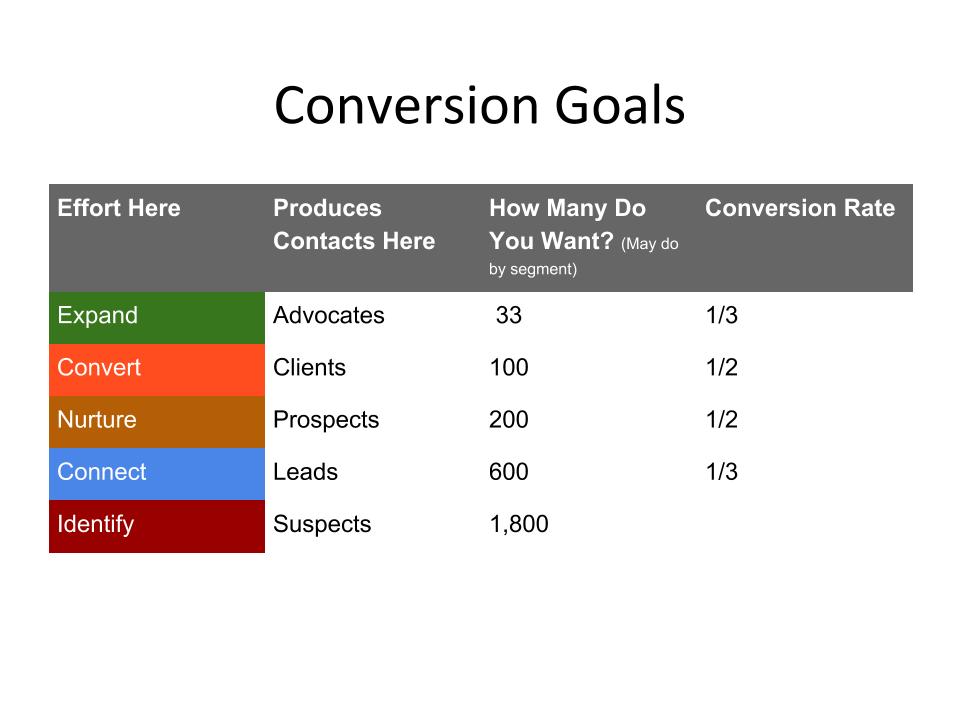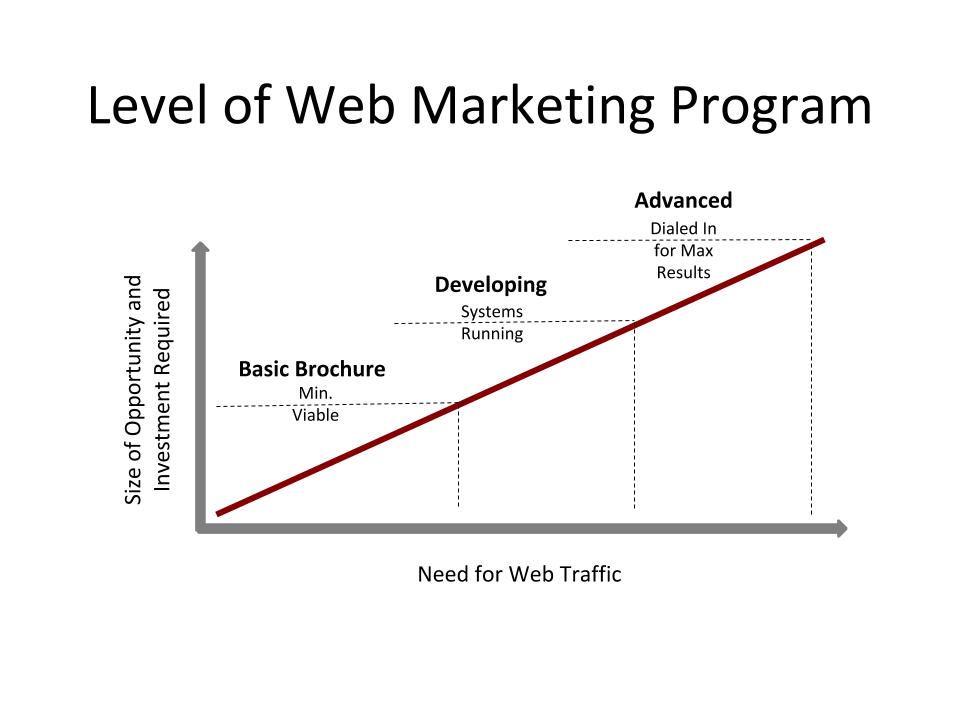Preface
I’ve managed hundreds of sales and marketing initiatives over twenty-five years. Throughout that time I’ve experienced both great successes and blind-sided failures. My hope is that this paper provides valuable insights and offers business owners and managers a guide to making the right choices for managing their web marketing programs.
Thank you for reading.
Everyone runs their businesses and web marketing programs a little different. But, as the famous quote from Winston Churchill goes, “Failure to plan is planning to fail.” It all comes down to whether or not a business manager wants to proactively set business goals and continually take steps toward achieving them. If someone decides to be proactive, the next question is “How does your web marketing program contribute to achieving those goals?”
Step 1 – Determine the Required Impact of Your Web Marketing Program
Let’s be honest, a full-blown, high-performance web marketing program isn’t always required. With over 25 million businesses in the United States, it stands to reason that the necessity for websites, ongoing content publishing, social media, SEO and paid traffic varies dramatically.
For instance, a specialized sales rep firm that relies on word of mouth and personal relationships to establish who they represent probably doesn’t need much more than a few-page, brochure-style website. When they occasionally pursue a new client, the prospect visits their website by directly searching their name or typing in their URL. The content needs to accurately represent the rep firm’s capabilities and convince the prospect that they are talking to the right team.
 On the other end of the spectrum, if you’re selling B2B technology, manufacturing equipment or supplies, there is a significant need to serve your clientele pre-sale. Statistics vary but the current rule-of-thumb as referred to in “The Buyer’s Journey, Demystified by Forrester” is that 60% of a buyer’s decision has been made by the time they talk to a salesperson!
On the other end of the spectrum, if you’re selling B2B technology, manufacturing equipment or supplies, there is a significant need to serve your clientele pre-sale. Statistics vary but the current rule-of-thumb as referred to in “The Buyer’s Journey, Demystified by Forrester” is that 60% of a buyer’s decision has been made by the time they talk to a salesperson!
Of course, if you’re an e-commerce business, it goes without saying that your web marketing program needs to be dialed in.
Step 2 – Get Really Clear on Your Purpose, Position, and Plan
Wherever your business is on this spectrum it’s important to get clarity on your business’ purpose, positioning and action plans. Here is a basic outline to help lay your strategic foundation. Contact us if you need help with this process or would like to utilize some of our workshop templates.
Strategic Planning Outline
- Purpose
- Mission
- Vision
- Values
- Positioning
- Product / Service Offerings
- Target Markets and Buyer Criteria by Product / Service
- Competitive Positioning by Product / Service
- Branding and Communications Guidelines
- Plan
- Long and Short Term Goals
- KPI’s
- Marketing Calendar and Budget
Here are a few branding and campaign examples that have come out of this process:
Grabill Cabinets Rebrand and Brochure
Libart PanoraView Product Microsite and Brochure
Loader Parts Source Branding (website built by LPS), Ads & Newsletters
Polar Clean Logo Update and Strategic Messaging
Precision Stamping Branding and Messaging Direction (website built by Effect Web)
Solution Source Brand Update and Service Branding
Step 3 – Create an Appropriate Digital Marketing Plan, Website and Dashboard
Bottom line here is that you can’t manage what you can’t see. Here are few thoughts for each of the places along the Level of Web Marketing Program spectrum.
Basic Brochure – Minimum Viable Website and Social Media
You may not need a lot of traffic, but wouldn’t you like to know when a key prospect visits your site and what they looked at? If you’re using one of our MarTech solutions like ONTRAPORT, you will likely have been staying in touch with a prospect over time and they visited your site by clicking on a tracked link within an email or text message. ONTRAPORT records and can automatically notify you of the visitor. The pages visited are also recorded.
When it comes to technical SEO and user experience, there are still some basics that you’ll want to follow:
- Do some basic keyword research to load your page titles and content with terms that your target audience use so it’s easier to find your site and understand what it’s about.
- Keep the content focused on your target visitors’ needs. If it’s truly just to confirm your capabilities, then no need for a bunch of blog content and fluff.
- Obviously, do a great job of communicating your positioning and representing your brand.
- Create matching social media channels and link to them from your site but don’t worry about spending a lot of time on them.
- Commit to a periodic maintenance schedule; quarterly or at least twice a year. Make sure your content is up to date and have a professional make any technical updates that may be required like plug-ins, themes, WordPress level, etc.
Here are a few examples of our clients that have successful brochure sites:
For the sake of tracking things like online visibility, traffic, user flow, and lead generation it’s really more work and expense than is required at this level. We recommend simply keeping aware of some basic Google Analytics data.
Developing Level – Systems Running
At this level, you need enough traffic, lead generation and resulting sales that it makes sense to set specific goals and track your performance on a dashboard. You’re also going to need a website that is SEO optimized with onsite content, back-end technical structure, and user experience.
What is SEO?
Search Engine Optimization (SEO) used to be looked at as a stand-alone service. It was something you “did to” a website in order to rank higher on Google (primarily). The problem with that was the massive gap between those old tactics and user experience. Google has drastically closed that gap so that user experience is the top priority. That said, it is extremely important that you have a keyword strategy and design your sitemap to reflect that. All content on your website needs to be in alignment with your keyword strategy and properly placed with titles, headings, alt tags on images, meta descriptions and video descriptions.
Beyond the keyword and proper content publishing, there are many back-end, technical SEO best practices to ensure only the right pages are indexed by Google, the site loads fast and that all plugins, themes, and components are kept up to date. There are also several best practices for consolidating how content is placed, how images are compressed and how the site’s server functions. These seemingly “invisible” factors have a significant impact on whether or not a site is easily found online.
Most importantly, if you’re expecting your site to be visible online it is imperative to change your paradigm from “Set it and forget it” to “Fresh is best.” Google and other search engines like websites with a “pulse” that are continually improving the user experience. Think of your website as if it were your digital office. When people visit, what happens? What door did they come in? Who did they encounter? How did you make their day? Are you monitoring user experience and working on ways to improve it?
I often hear people ask, how can we rank #1 for XYZ keyword? My answer, if you want to rank #1, be #1. Stop analyzing, stop talking and starting “Being #1” to your market. What does the top performer in your market need to look like online, offline, internally, socially, structurally, talents, etc? That’s how you rank #1.
Maintenance vs. Responsibility for Performance
A lot of companies make the mistake of only “fixing” it when they think it’s broken. It’s like only going to the doctor when you’re extremely sick or injured. If your site’s “invisible” factors are failing, you may not notice it when you “look over” your site. But rest assured, they will catch up with you in terms of people not finding your site and eventually have things break. If your company is in the developing stage or higher of the web marketing program spectrum, you need to take a proactive approach to optimize performance.
The biggest issue here is “Who do you trust?” Put ten “web development experts” in a room and get ten different opinions about what the best practices are. The internet has more content about SEO, user experience and proper web design best practices that you could ever read in a lifetime.
Like anything else in life, whether it’s the right head coach of a football team, the right sales manager or the right web director, it all comes down to performance. That is why it is SO IMPORTANT to set specific goals and track your performance. If your head coach is winning games you probably don’t care which books he has kids read, which exercises he has them doing or which blocking and tackling method he’s teaching. You just see the wins. When it comes to web performance, different web directors will have different preferences for the tools they use, the methods they prioritize and things they choose not to worry about. My advice? Focus on the results and do enough homework that you know you’re not paying for smoke and mirrors. Ask questions, be curious, but don’t try to out expert the expert. Choose someone who will take ownership of the responsibility to produce results.
At Spearhead, we don’t sell “web maintenance” packages. We sell Web Performance Responsibility. There’s a big difference. Contact us to learn more.
Tracking Results – The Digital Dashboard
Each company’s specific dashboard structure and data sources will vary a bit. However, we do have a standard starting point. Ultimately we’re looking for a single page display of KPI trends so that we can quickly diagnose problems and zero in on opportunities. Here is an example:
This dashboard is organized by steps of the buyer/seller journey. As the seller, your job is to identify enough traffic, connect with enough leads, keep enough leads engaged, convert those leads into sales and expand those clients into more business. To set the goals for each stage you’ll need to create a baseline of conversion percentages like this:
The KPI Dashboard serves as a quick indicator. Behind the dashboard lies the detailed analysis of things like user flow, channel sources, on-site goal conversions, etc. Here is a list of our starting point KPIs:
- Online Visibility vs Competitors (We use SEMRush)
- Traffic (Sessions from Google Analytics)
- Lead Capture (We use ONTRAPORT (OP) or Hubspot forms)
- Lead Engagement (OP or Hubspot email opens, clicks, site re-visits)
- Sales Conversion (Depends on your ERP or sales system)
- Client Expansion (Depends on your ERP or sales system to track sales growth by client)
- Referral Development (Depends on your system but we can use ONTRAPORT’s affiliate tracking system)
Most social media and paid traffic sources will have their own reporting dashboards so we try not to muddy up these higher level items. Of course, those other sources requires in-depth planning and management. We’ll take a deeper look at those channels in a different paper.
Some example of our Developing Level web marketing programs include:
Advanced – Dialed in for Max Results
At this level, it’s an all-out digital system from the early stage of a buyer’s journey all the way through check-out, up-sell and cross-sells. Tools like ONTRAPORT, Hubspot or other marketing automation tools are used to engineer very sophisticatedly, choreographed experiences. Emails, texts, notifications, reminders, offers, etc are all pre-programmed based on what a buyer does or doesn’t do.
These websites often times require advanced development and very special attention to SEO factors as well as high-end creative content. Everything else I described for the “Developing” stage in terms of performance management and dashboard reporting applies here as well.
Here are a couple of examples:
- stoett.com – generating 1,000’s of leads per month and automatically dispatching them to dealers all over the country while also selling featured products online with an automatic ERP integration. There is a lot going on here.
- southbendclutch.com – this a “Ferrari” of a website in terms of the massive parts database behind the “find a clutch” tool as well as the proprietary coding of the site and creative elements.
Summary
ONE – What level do you need your web marketing program to perform in order to achieve your business goals?
TWO – Are you crystal clear on your company’s Purpose, Position, and Plan? Do your website and other communications effectively communicate your purpose and position?
THREE – If your program is in the Developing or Advanced stages, are you actively tracking performance and optimizing your systems?
If you’re interested in understanding the elements of a website in greater detail, click here to download our web planning guide.
As always, we’re here to help. Feel free to contact us for assistance.



